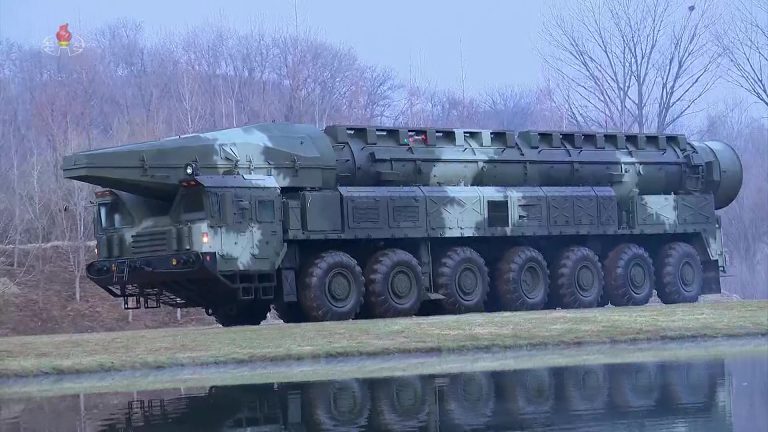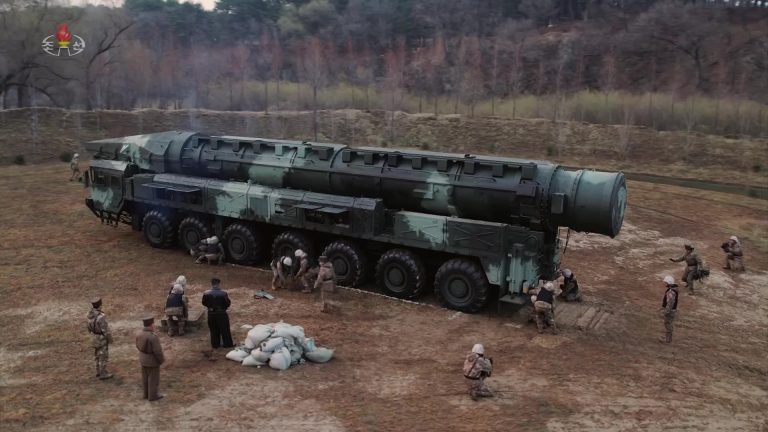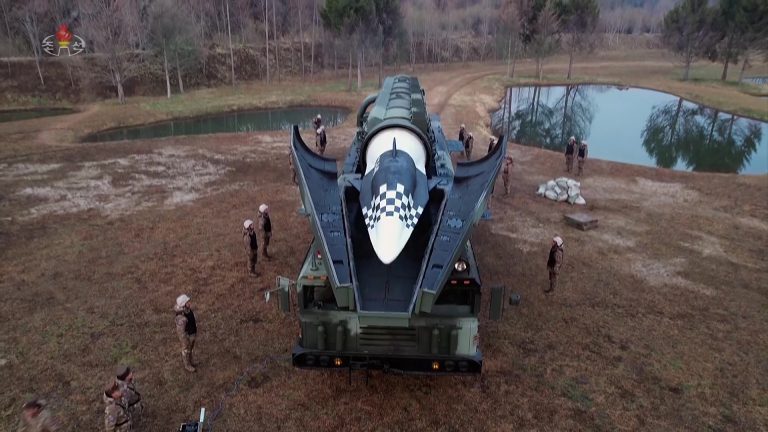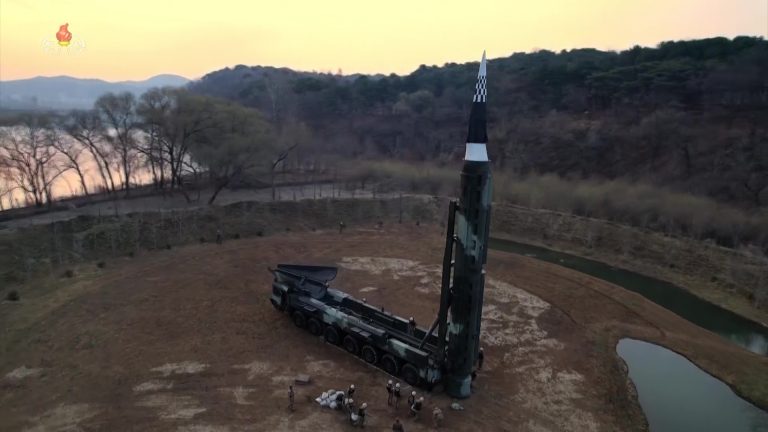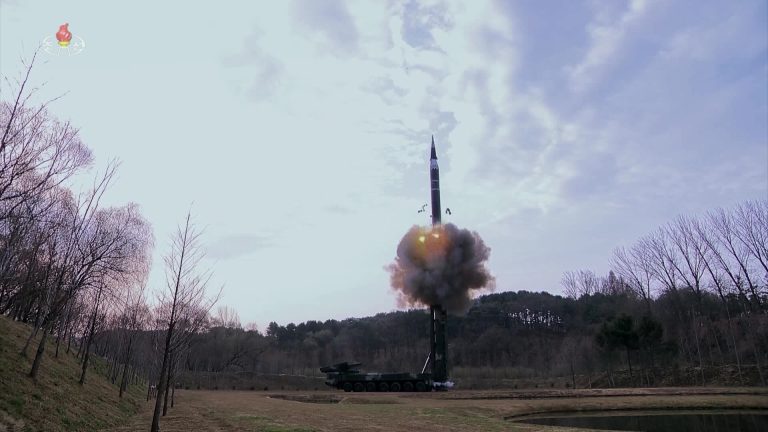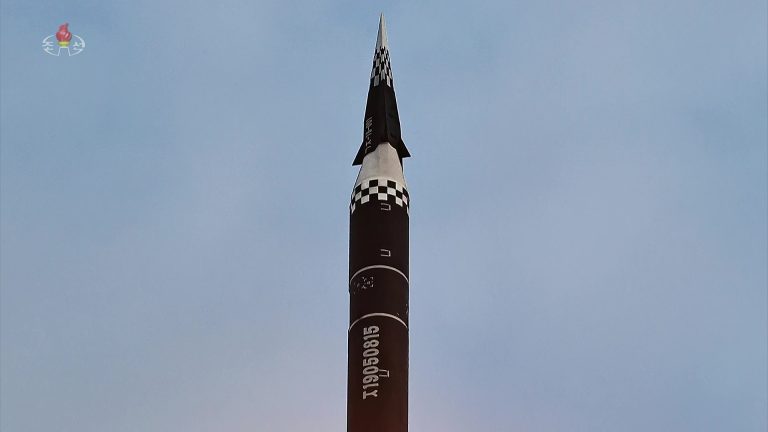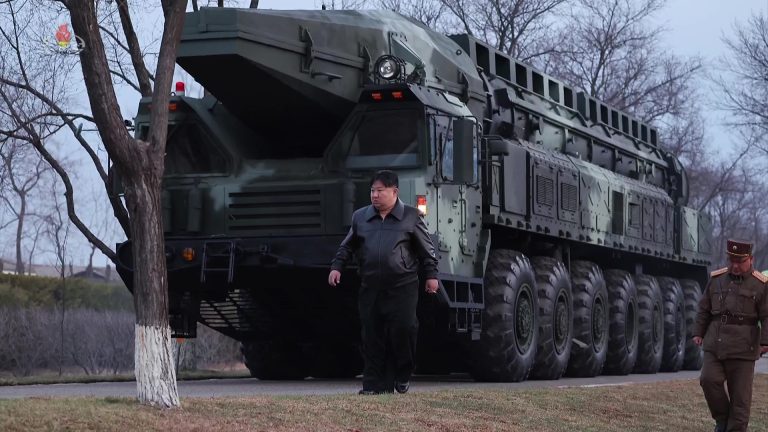Second Flight of North Korea’s Solid IRBM Also Second Flight of HGV
On April 2, North Korea conducted the second flight test of a solid-propellant intermediate-range ballistic missile (IRBM), which it designated the Hwasong-16B (HS-16B). The missile carried a hypersonic glide vehicle (HGV) payload akin to one first flown in September 2021 on a liquid-propellant booster. The booster portion of the April test appears to have succeeded, but the success of the HGV payload is unclear.
The North probably considers the booster portion of the solid IRBM system ready for operational deployment, or will after one more flight test. In the near term, however, a deployed system would almost certainly carry the maneuvering reentry vehicle (MaRV) payload demonstrated in the IRBM’s first flight this January, rather than the HGV. (The MaRV version presumably is designated HS-16A.) Compared to a MaRV, an HGV has the potential to conduct much wider maneuvers over a much greater portion of its flight, thus better penetrating missile defenses. But the North’s HGV payload is probably at least several successful flight tests away from deployment, given the materials and guidance challenges of its demanding flight regime and the time it has taken China and Russia to develop their own HGVs.
According to the North, this test represented “perfecting the project for putting all the tactical, operational and strategic missiles with various ranges on a solid-fueled, warhead-controlled and nuclear warhead-carrying basis.”[1] This probably is meant to note that North Korea has successfully developed solid-propellant ballistic missiles across the entire spectrum of ranges, not that solids will be replacing liquids entirely. IRBMs—both solid and liquid—have a compelling military mission against US bases in Guam, the Philippines, and farther-flung reaches of Japan, as well as US missile defense radars in the western Aleutians.
Information to Date
On March 19, North Korean media reported[2] the ground (static) testing of “a solid-fueled engine for a new-type intermediate-range hypersonic missile, which is of another strategic value.” Because of the successful test, “a timetable for completing the development of the new-type intermediate-range hypersonic missile weapon system was set.” The report quoted Kim Jong Un as saying that “the military strategic value of this weapon system is appreciated as importantly as ICBM.”
On April 2, North Korea launched an apparent IRBM to a range of about 600 kilometers (km), according to South Korean military assessments. Japan’s military reported that a ballistic missile flew to the northeast to a range of over 650 km at a maximum altitude of about 100 km, taking about 10 minutes.
The next day, North Korean media reported “the first test-fire of Hwasongpho-16-Na, a new-type intermediate-range solid-fueled ballistic missile loaded with newly-developed hypersonic glide vehicle.”[3] (The missile name would be rendered in English as “Hwasong-16B,” or HS-16B.) The missile reportedly made a successful 1,000 km flight with a maximum altitude of 101.1 km, and subsequently engaged in a pull-up maneuver reaching an altitude of 72.3 km, as well as lateral (cross-range) maneuvering. The 1,000 km range reportedly resulted from “forcibly controlling the speed and altitude by means of delaying the start-up of the second-stage engine and rapidly changing the flight orbit in the active region.” The media report also claimed that the flight test of the missile, which it termed as having “another military strategic value,” represented “perfecting the project for putting all the tactical, operational and strategic missiles with various ranges on a solid-fueled, warhead-controlled and nuclear warhead-carrying basis.”
The North released photos and video showing what appeared to be the same type of solid-propellant IRBM first launched earlier this year on January 14, but this time carrying a wedge-shaped HGV akin to one first flight-tested in September 2021 on a Hwasong-8 (HS-8) liquid-propellant medium-range ballistic missile (MRBM)-class booster. The solid IRBM was launched from a seven-axle, wheeled, transporter-erector-launcher (TEL) featuring an open-front canister or launch tube in which the booster portion of the missile was housed. When stored horizontally on the TEL, the HGV payload attached to the top of the booster was protected by a two-part, hinged clamshell cover that opened to each side prior to the missile being erected for launch. The missile was “cold launched” by a gas generator located at the aft end of the canister/launch tube, which popped the missile up from the canister/tube prior to ignition of its first stage.
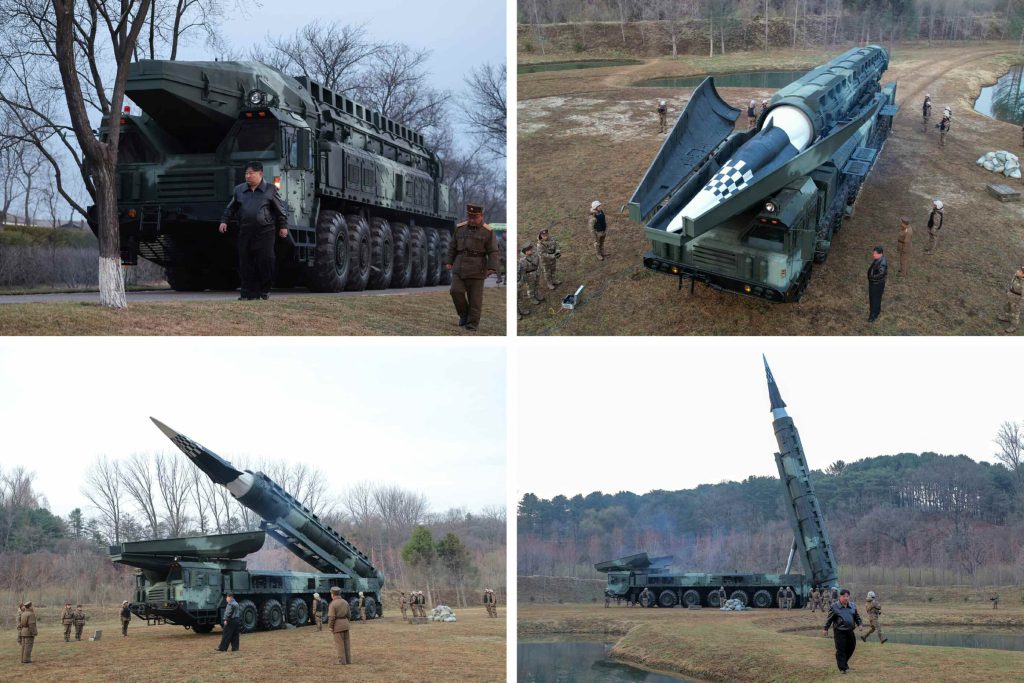
JUST IN: North Korean TV shows video of the Tuesday morning launch of the Hwasong-16B. It says the missile is a “new-type intermediate-range hypersonic missile.” pic.twitter.com/anrWwpJel2
— Martyn Williams (@martyn_williams) April 3, 2024
Figure 3. Video clip from Korean Central Television broadcast from April 3, 2024. (Source: Martyn Williams)
Despite the North Korean claim of a 1,000 km flight, the South Korean military reported on April 3 that the ROK, Japan, and the US had agreed on a final estimated flight distance of “about 600 km” and claimed the flight data North Korea published was “exaggerated and different from what our military analyzed.” South Korea also claimed that the North had exaggerated the delayed ignition of the second-stage and the rapid change in the missile’s “flight orbit,” further calling the North’s range claim into question.
Analysis and Implications
The missile part of the system is about ready. This is the second apparently successful flight of the solid IRBM, which North Korea likely designates as the HS-16. Given past practice, it probably considers the booster ready for operational deployment, or will after one more flight test—especially since the two stages of the HS-16 are probably based on the first two stages of the previously-tested three-stage HS-18 solid-propellant ICBM.
If the HS-16 is deployed in the near-term, however, it would almost certainly carry the MaRV payload used this January, rather than the HGV. (The MaRV version presumably is designated HS-16A.) The MaRV was tested twice in January 2022 on the HS-8, apparently successfully, and North Korea suggested at that time the payload’s development had been completed.
But the HGV payload has a long way to go. Compared to a MaRV, an HGV has the potential to conduct much wider maneuvers over a much greater portion of its flight, thus better penetrating missile defenses. This is probably behind the North’s references in March and April to the HS-16B providing “another strategic value,” that is, presumably beyond the MaRV. But it is unclear whether either the first flight-test of North Korea’s HGV in 2021 or the latest flight of the payload was successful.
If South Korea’s claim is true that the US—whose infrared satellites and other intelligence means should be able determine the ground truth—agreed that the latest test flew to only about 600 km, rather than the 1,000 km claimed by North Korea, that would be a pretty clear indication of an HGV test failure. In any case, the North’s HGV payload is probably at least several successful flight-tests away from deployment, given the materials and guidance challenges of its demanding flight regime and the time it has taken China and Russia to develop their own HGVs. (The North could reach this milestone more quickly if it received assistance from one or both of those countries.)
Launcher oddities are probably missile-related. The HS-16B missile probably is “cold launched” from an open-ended canister or launch tube, rather than a sealed canister like the HS-18 ICBM, because the width of the HGV payload extends so far beyond that of the booster. A sealed HS-16B launch canister would have to use a large, bulbous front section or have the entire canister be the width of the HGV, either of which would have complicated mounting the canisterized missile on the TEL and transporting it in the field. The HS-16B TEL probably uses a protective cover over the exposed HGV payload, which extends beyond the canister/launch tube, in order to protect the outer skin of the HGV, which must be intact to survive the extreme temperatures of flight. (The Chinese protect the HGV on their road-mobile, hot-launched DF-17 IRBM by tucking it into a recess in the top of the TEL.)
Moving to an all-solid force is highly unlikely. It is unclear what North Korean media meant by saying that “the project for putting all the tactical, operational and strategic missiles with various ranges on a solid-fueled, warhead-controlled and nuclear warhead-carrying basis” had been “perfected.” One possibility is that the North was announcing an intention to phase out all its liquid-propellant ballistic missiles in favor of solids. Alternatively, the North may have been noting its successful development of solid-propellant ballistic missiles across the entire spectrum of ranges, but not that solids would replace all liquids. One source reports that the latter is a more faithful translation of the original Korean. Moreover, given the range/payload advantages of liquids over solids—especially for carrying large payloads like the “multiple reentry vehicles” and “super-large hydrogen bombs” touted by Kim Jong Un in January 2021—and the North’s existing large inventory of liquid missiles and substantial investment in liquid production infrastructure, it is highly unlikely that Pyongyang intends to phase out liquid-propellant ballistic missiles.
IRBMs remain important. It is perfectly plausible that Kim Jong Un would regard solid IRBMs as having “military strategic value… as important as ICBMs.” These systems have a compelling military reason to exist, having the ability to disrupt bases in Guam, the Philippines, and farther-flung reaches of Japan that could support US operations against North Korea, as well as US missile defense radars in the western Aleutians. Additionally, North Korea has put resources against this mission. It has already developed the liquid-propellant Hwasong-12 (HS-12) IRBM, carrying a traditional nuclear reentry vehicle, and suggests it has been operationally deployed since as early as January 2022. And as noted above, it is now in the late stages of developing the HS-16 solid IRBM, which probably will be initially deployed with a MaRV, while the HGV payload continues development.
Conclusion
North Korea will continue to devote resources and priority to the IRBM force, probably including the liquid HS-12 as well as the new solid HS-16. Equipping a version of the HS-16 with a traditional reentry vehicle is a strong possibility. HGV development will apparently continue as well, which could also have future use in the ICBM force. Success in the HGV program is far from certain given the technical challenges, especially without help from China and/or Russia. But the more mature MaRV program still provides a robust means for North Korea’s IRBM force to combat US missile defenses on Guam.
- [1]
“DPRK Missile Administration Succeeds in Test-fire of New-type Intermediate-range Hypersonic Missile,” Korean Central News Agency, April 3, 2024, http://kcna.kp/en/article/q/afce7f7dbed19a4ea073506c749987c3.kcmsf.
- [2]
“Respected Comrade Kim Jong Un Guides Test of Solid-fueled Engine for New-type Intermediate-range Hypersonic Missile,” Korean Central News Agency, March 20, 2024, http://kcna.kp/en/article/q/df6d1221b529ef07489333eafd585420.kcmsf.
- [3]
“DPRK Missile Administration Succeeds in Test-fire of New-type Intermediate-range Hypersonic Missile,” Korean Central News Agency, April 3, 2024, http://kcna.kp/en/article/q/afce7f7dbed19a4ea073506c749987c3.kcmsf.

